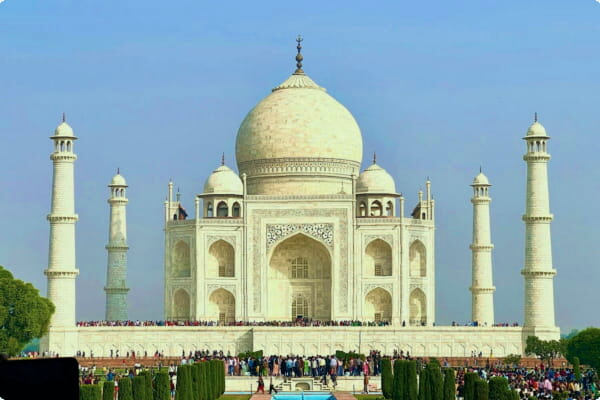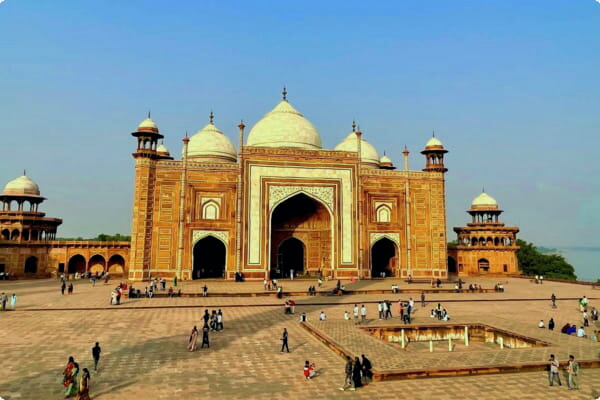Known for its white marble and elegant architecture, the Taj Mahal is a famous site in Agra, India. The structure was built in 1631, and was commissioned to house the tomb of Mumtaz Mahal. In addition, it houses the tomb of Mughal emperor Shah Jahan. The building is a UNESCO World Heritage Site.
UNESCO World Heritage Site
Located in Agra, India, the Taj Mahal is an ivory-white marble mausoleum that was built by Mughal Emperor Shah Jahan in memory of his wife, Mumtaz Mahal. This mausoleum has become the symbol of India and its rich heritage.
The building is a testament to the beauty and elegance of Mughal architecture. It is one of the most iconic monuments in the world. It has been recognized as one of the world's Seven Wonders. The complex is divided into two parts: a white marble mausoleum and a red sandstone side.
The Taj Mahal complex has undergone significant repair and conservation work. It has also been monitored for air quality, atmospheric pollutants, and decay factors.
Four minarets lean slightly outwards
During construction, workers tilted four minarets at Taj Mahal. This was done in order to safeguard the building from falling in an earthquake. There is a theory that sub-soil displacement may have caused the tilts.
The leaning was supposedly intended to create an optical illusion. When viewed from a distance, the Taj appears larger. However, if an earthquake were to strike, the minarets would fall away from the main tomb, preventing grave damage.
According to Agam Mathur, a historian at Rajasthan University, the leaning of the minarets was not an accident. Instead, it was an architectural design decision. In fact, the same building was constructed on the east side of the tomb for symmetry.

Flowers are symbols of the divine realm
Symbolic of the divine realm, flowers were used to decorate the Taj Mahal. The Mughals had a penchant for roses and irises, whose beauty was said to be unrivaled by their contemporaries. The Taj was built in 1632, using a blend of white marble and red sandstone and costing 41 million rupees to build.
The building itself is an octagonal design, and its gardens are a riot of colour. The mausoleum floor is paved with a geometric pattern, and the pishtaqs are decorated with a series of vases containing the flowers of the day.
The best part of the Taj is its proximity to the city, and it is possible to drive a non-polluting vehicle within two kilometers of the site. The garden is divided into sixteen flower beds. The Taj is closed to visitors on Fridays for prayer.
Elephants were the main means of transportation during those times
During the times of the Mughal Empire, elephants were the primary means of transport for heavy materials. Several thousand were involved in the construction of the Taj Mahal complex, along with several other Mughal structures.
One of the most interesting features of the Taj Mahal is its garden, which was originally a symmetrical mix of daffodils, roses, and other flowers. The red sandstone used to construct the building was imported from all over India and the Middle East. Turquoise was imported from Tibet and lapis lazuli was brought over from Central Asia.
Although the name Taj Mahal sounds like it's in trouble, the Mughal Empire actually survived until 1762, when the Jats sacked the city. Its collapse put the Taj at risk of being destroyed by the British colonizers, who plundered it of precious gems and hand-woven carpets.

White marble has turned yellow due to high pollution levels
Despite spending $150 million for a thorough restoration of the Taj Mahal, its white marble facade has continued to turn yellow. The cause is air pollution. The monument is situated on the banks of the river Yamuna, a polluted body of water.
The Supreme Court has ordered the Archaeological Survey of India (ASI) to submit a Site Management Plan to address the problem. The Plan is a holistic approach to the conservation of the monument. It has been submitted to the court as a response to a plea by M.C. Mehta, an environmentalist who approached the court about the changing colour of the marbles.
Mumtaj Mahal was buried at two different places after her death
During the reign of Shah Jahan, Mumtaz Mahal was the main consort of the Mughal emperor. The two of them had thirteen children together. During their marriage, they traveled across the Mughal empire and participated in military campaigns. Their relationship was deeply intense. They were adored by each other.
Mumtaz's death was a devastating blow for the emperor. She died in Burhanpur, in the Deccan. The body was embalmed using a special technique to prevent decomposition. After she was buried, her remains were moved to Agra. The former emperor's body was positioned in a sarcophagus next to Mumtaz's. The two were buried in a tomb called the Luminous Tomb.





